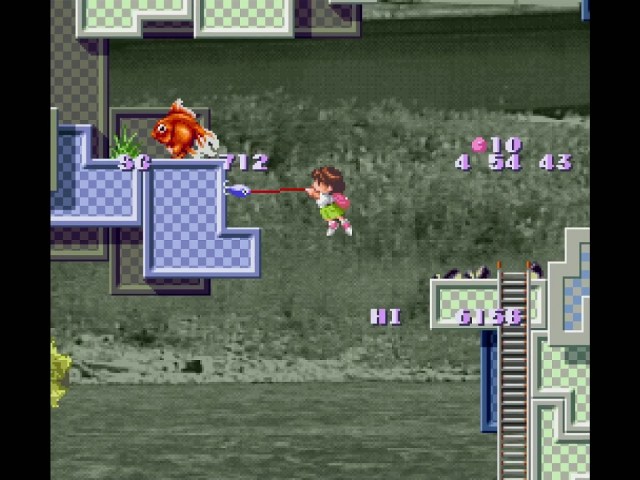Umihara Kawase is a weird game to explain, but I’m going to try to anyway. It looks and sounds like an amateur production put out by some unknown publisher and created by some unknown developer, and maybe it is. But it’s also one of the best games on the Super Famicom.
I first heard about it on GameCenter CX (season 5, episode 1), and that was around the time that the series was finally making it stateside with Yumi’s Odd Odyssey (Sayonara Umihara Kawase). I finally jumped into the series in 2020 with Umihara Kawase Fresh, which was the topic of my second review ever written here at Destructoid. I absolutely loved it, which made me go back and finally play the earlier titles.
And you should, too.
 Screenshot by Destructoid
Screenshot by Destructoid
Rubber banding
Umihara Kawase is a game that is built entirely around its central mechanic, sort of like, er, the Kuru Kuru Kururin series, maybe. I’m drawing a blank, but I don’t mean it’s like Bubble Bobble, where you blow a lot of bubbles but it’s still action platforming; Umihara Kawase’s entire identity is based around its core unique idea.
And its core idea is a fishing line. The eponymous Umihara can barely jump, but she can cast a line like an expert angler. Or Batman. Probably more like Batman. You use it as a grappling hook, sinking your lure into a solid object and then using it to swing across gaps and over hazards. And yet, this isn’t Bionic Commando. Umihara is as graceless as a fish out of water, and the fishing line appears to be made of rubber, so she bounces and slingshots around.
It’s tempting to say that Umihara Kawase is easy to learn and difficult to master, but it really isn’t that first thing. Getting used to the physics so you can perform even the simplest of tasks will probably take a while, and getting to the point where it becomes second nature is a long journey. Even then, the more advanced maneuvers that the game enables may be out of reach unless you really get sucked in.
 Screenshot by Destructoid
Screenshot by Destructoid
Legged fish
However, it doesn’t make things comfortable. Despite its cute appearance of a little schoolgirl working her way across abstract labyrinths, it’s an extremely brutal game, and there are layers to its brutality.
Beyond the unconventional movement system, there are no continues, and all death is instant. There are enemies in the form of various sea creatures that haunt the levels, and gently brushing against most of them will instantly drop Umihara to the floor. Aside from lives, there are no power-ups to help you. It’s just you and your fishing line.
The actual rules of the game are similarly difficult to get a grasp on. There are 57 levels, but they don’t progress in a strictly linear fashion. Some levels have multiple exits that will take you forward or backward to different fields. There are bosses, which are rather cryptic puzzles on their own, but running into them is neither a guarantee or requirement. But more mysteriously, it’s also unclear where the end of the game really happens.
In the GameCenter CX episode I mentioned, Arino reaches the end credits rather early. But then, his staff explains to him that, after 30 minutes, the game will just skip you ahead to the last level. They suggest that he needs to reach field 57 in under 30 minutes to get the game’s good ending, which, even knowing the quickest route, he fails to do.
However, after the show, the staff members go to work and actually manage to complete Umihara Kawase in under 30 minutes, at which point they get the same non-ending that Arino got. So, even the game doesn’t have any recognition for whether you took too long and got shunted to the end or if you beat it before its timer ran out. It just ends either way. So, what is even considered “winning” here?
 Screenshot by Destructoid
Screenshot by Destructoid
Child’s play
I suppose it’s really up to you to challenge yourself. Umihara Kawase is more of a playground. A series of challenges for you to overcome, but contrary to its initial difficulty, it is easygoing about how you approach it.
Maybe, instead, you just challenge yourself to see every field. Or maybe, like the GameCenter CX staff, you try to beat it before 30 minutes are up. That’s kind of disappointing in its own way. I like to be told I did a good job. On the other hand, high-level play just looks incredible.
The fact that there isn’t really a set goal is one of the ways Umihara Kawase feels sort of amateur. Beyond that, the graphics look thrown together. The background is just a photograph of the ocean, which gives it the feeling of a neglected arcade game. The ice rink where I lived growing up had a few arcade cabinets, and one of them was Buster Bros. or Pang!, which did the same thing. In lieu of a background, they just slapped unrelated images of, like, the Taj Mahal behind the action. It always seemed uncomfortably weird to me when I was a kid, and that’s the feeling I get here.
To add to that, all the platforms in the game are just abstract blocks of different colors. Every once in a while, you get something with a little more effort to it, like platforms made of pencils or giant eggplants, but they’re rather sparse. Mainly, you’re just looking at blocks that look like placeholders. In a way, this gives the game an ethereal, dream-like (if not entirely monotonous) quality. The fact that all the exits are just modern Japanese-style front doors just adds to this.
Meanwhile, the music sounds like the soundtrack to a series of travel promo videos.
And, by the way, the HUD being so close to the middle of the screen is how it’s supposed to look. That isn’t a glitch on my version of the game or something.
 Screenshot by Destructoid
Screenshot by Destructoid
Fish hooks
I don’t have any hard data, but I don’t think Umihara Kawase did all that well during its 1995 release in Japan. That’s kind of unsurprising because I don’t know how you draw attention to a game like this. In a market full of jump-guys and shoot-guys, a little girl with a backpack and fishing rod isn’t what people tend to look for. The developer, TNN, seems to have only done one other game before ceasing to exist. At that point, the key staff members formed Studio Saizensen, who are perhaps best known over here for Code of Princess.
Umihara Kawase would continue on with Studio Saizensen, first following up with Umihara Kawase Shun in 1997 on PS1, then Sayonara Umihara Kawase in 2013 on 3DS, with Umihara Kawase Fresh being the most recent release in 2020. While, again, I don’t have any sales data, I’m assuming that the series is being kept alive by a cult following and the studio’s own passion.
And while no publisher was brave enough to release the games in North America until Yumi’s Odd Odyssey in 2013, all the titles are now available on PC via Steam. The original Umihara Kawase even made it to the Switch’s Online service, but only in Japan. Considering the game is completely playable without needing a translation, it’s a little strange that it hasn’t made it to other regions, but maybe Nintendo will fix that at some point because more people need to play this bizarre game.
Truly, though, if you’re interested in the series, either Sayonara Umihara Kawase or Umihara Kawase Fresh are better starting points. The rubber-band physics don’t change a whole lot across the series, but both those games offer better progression. You can learn the basics from those friendlier experiences before your fish grappling skills are put to the test.
For other retro titles you may have missed, click right here!

Zoey Handley
Staff Writer – Zoey is a gaming gadabout. She got her start blogging with the community in 2018 and hit the front page soon after. Normally found exploring indie experiments and retro libraries, she does her best to remain chronically uncool.
More Stories by Zoey Handley
>>> Read full article>>>
Copyright for syndicated content belongs to the linked Source : Destructoid – https://www.destructoid.com/umihara-kawase-for-snes-has-legs-under-its-bargain-bin-exterior/?utm_source=rss&utm_medium=rss&utm_campaign=umihara-kawase-for-snes-has-legs-under-its-bargain-bin-exterior






























